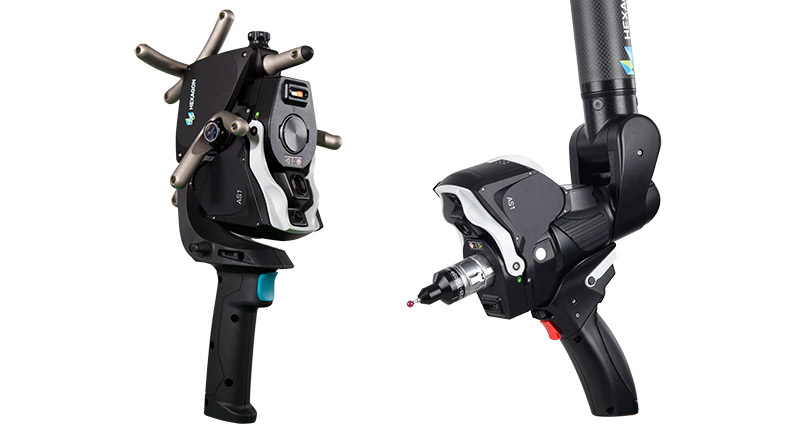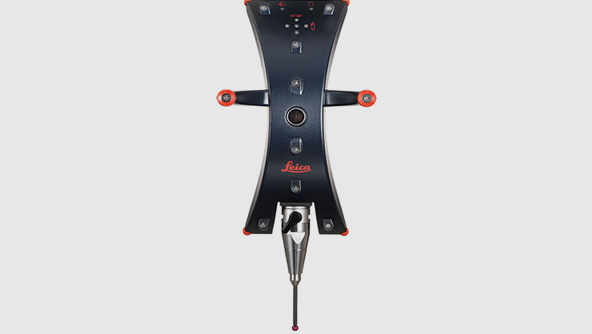High-performance resources to meet aeronautics standards and regulations
Rodrigo Alfaia – Laser Tracker Product Director, Hexagon’s Manufacturing Intelligence division

POTEZ AÉRONAUTIQUE’s quality control system
Their system includes a Leica Absolute Tracker AT960, accompanied by an Absolute Scanner AS1 and a Leica T-Probe, meets the highest standards of its prestigious customers
POTEZ AÉRONAUTIQUE’s innovation drive is based on two key objectives: to constantly improve the performance of its resources and products, while adopting an increasingly environmentally-friendly approach. They are investing in Industry 4.0 by introducing innovations in industrial processes, such as automation, cobotics and digital control systems. The company is also focusing on product innovation through a number of research and technology projects in composite materials and door systems.
A family heritage of innovation
Today, innovation plays a key role in the company’s development strategy. As a Tier 1 and Tier 2 supplier, POTEZ AÉRONAUTIQUE enjoys the trust of long-standing partners and many major players who will shape the future of aviation.Following the acquisition at the end of 2019 of POTEZ COMPOSITES, a Lot-based company specialising in the manufacture of elementary composite parts, the group has extended its range of skills to include aircraft interior fittings. Here too, the group offers design and manufacturing services. By adapting to the specific needs and requirements of its customers, both in terms of quality and deadlines, the company is able to intervene in both series production and prototyping activities.
Whether it’s for business class seat shells, coverings or interior fittings, POTEZ AÉRONAUTIQUE works on technical components with standard or premium finishes for major customers. For example, the company contributes to the production of premium, made-tomeasure seats for airlines, with composite moving parts mounted on mechanical systems, as well as armrests (for comfort or ease of access for the disabled), partitions and retractable doors. They are then fitted, painted or decorated, and delivered to the manufacturer for final assembly. POTEZ AÉRONAUTIQUE is involved from the industrialisation phase through to the delivery of finished products, including co-design services.

Figure 1. Manufacture of aircraft doors.
Quality, safety and the environment
“We attach the utmost importance to the quality of our products, because they play an essential role on board aircraft, contributing to their safety in flight and on the ground. This is why we are committed to offering our customers the highest level of quality,” says Benjamin Andrianome, Process Engineer at POTEZ AÉRONAUTIQUE.POTEZ AÉRONAUTIQUE’s management system complies with aerospace and defence standards and regulations. Its quality control is backed up by high-performance equipment, including Hexagon as a supplier since 2012.
ISO standards and new contracts for
leading-edge slats
Standards are crucial in the aerospace industry, and the major principals require their suppliers to comply scrupulously with them. As a result, suppliers have to equip themselves with the methods and resources they need to meet these requirements as effectively as possible.POTEZ AÉRONAUTIQUE’s measuring arm and laser tracker were reaching the limits of their usefulness for checking large parts and finished sub-assemblies.
A new contract for the production of leading-edge slats (located on the forward section of an aircraft’s wing and designed to prevent air stream separation) convinced the company that it was time to renew its quality measurement resources, particularly in terms of scanner technologies for profile measurements.
“Our decision to invest in new technologies was motivated both by our customers’ requirements in terms of strict standards and new contracts, and also by our teams’ need to save time and improve quality, achieve better results and open up new opportunities,” recalls Andrianome.

Figure 2. External scan of a door using the Absolute Scanner AS1.
The team began by obtaining information from its customers, as well as from other suppliers and subcontractors, before carrying out a benchmark. In the end, POTEZ AÉRONAUTIQUE chose Hexagon once again.
“We stuck with technologies we were already familiar with, namely laser trackers. Mainly because of the ease of implementation, but also because of the speed,” adds Andrianome.
Hervé Capdevielle, 3D Controller and main user of the laser tracker at POTEZ AÉRONAUTIQUE, also remembers the process: “Yes, the choice was quite easy, particularly from a technical point of view. The Absolute Tracker with the Absolute Scanner AS1 and the Leica T-Probe offer a cutting-edge technological combination that provides unique flexibility in the means of measurement”.
Below are the criteria and key points that the Hexagon tracker and its accessories have successfully met:
- ISO-standard tool
- Precision of the measuring equipment
- Multi-disciplinary measuring equipment
- Suitability for measuring large parts
- Implementation in production
- Possibility of reverse engineering
- Measurement of hidden points
- Mobility of the metrology tool
- And above all, it saves time, with the aim of halving quality control time

Figure 3. The Absolute Scanner AS1 quickly measures large and small parts.

Figure 4. Precise measurement of parts with the Leica T-Probe.
Design, manufacture, set-up
The Leica Absolute Tracker AT960 is used at POTEZ AÉRONAUTIQUE for quality control at assembly level, in the inspection of series parts, for tooling requirements and in particular for all assembly frames, on which annual checks are carried out, as well as for large parts, up to 6 metres long.POTEZ AÉRONAUTIQUE produces as many mechanical parts as sheet metal parts, which do not require the same levels of precision. Mechanical parts are ‘run through’ on a CMM, while sheet metal parts are measured with the Absolute Arm.
“Our Absolute Arm is also used for various checks, such as when small parts are received from subcontractors, on composite parts, 3D printing and sheet metal parts,” says Andrianome.
A home-made culture
“Our corporate culture means that we try to keep as much of our know-how in-house as possible. Whether it’s tooling or, more recently thanks to our new resources, measuring. The team tries to be as autonomous as possible. For example, we have developed all the specific measurements for leading-edge slats, and there are other projects for the future.”
Figure 5. The Leica Absolute Tracker AT402 remains in daily action at POTEZ AÉRONAUTIQUE.

Figure 6. Hexagon’s older measuring equipment complements the quality department’s equipment and is used every day for tooling inspection.
Over a hundred years of history
The Potez story began indirectly in 1913, with the invention of the Éclair propeller. This revolutionary propeller, co-invented by Marcel Bloch (later renamed Dassault) and Henry Potez, equipped the majority of Allied aircraft from 1917 onwards. With it, Henry Potez designed over 100 prototypes and built more than 7,000 aircraft.
And it was in 1924 that Henry Potez built an industrial complex in Méaulte, his home town in the Somme, which was to become the largest and most modern aeronautical factory in the world until the nationalisations of 1936. In December of the same year, he presented his first plane – the Potez 25 – at the 9th International Aeronautical Exhibition, and it became a legend when Jean Mermoz and Henri Guillaumet flew it across the Andes on behalf of the Compagnie Générale Aéropostale.


